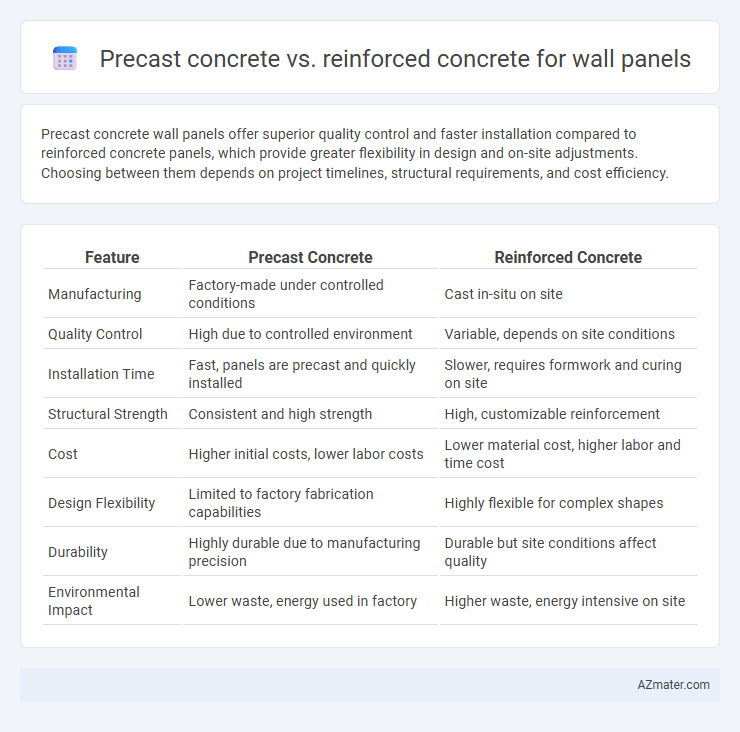Precast concrete wall panels offer superior quality control and faster installation compared to reinforced concrete panels, which provide greater flexibility in design and on-site adjustments. Choosing between them depends on project timelines, structural requirements, and cost efficiency.
Table of Comparison
| Feature | Precast Concrete | Reinforced Concrete |
|---|---|---|
| Manufacturing | Factory-made under controlled conditions | Cast in-situ on site |
| Quality Control | High due to controlled environment | Variable, depends on site conditions |
| Installation Time | Fast, panels are precast and quickly installed | Slower, requires formwork and curing on site |
| Structural Strength | Consistent and high strength | High, customizable reinforcement |
| Cost | Higher initial costs, lower labor costs | Lower material cost, higher labor and time cost |
| Design Flexibility | Limited to factory fabrication capabilities | Highly flexible for complex shapes |
| Durability | Highly durable due to manufacturing precision | Durable but site conditions affect quality |
| Environmental Impact | Lower waste, energy used in factory | Higher waste, energy intensive on site |
Introduction to Wall Panel Construction Methods
Wall panel construction methods primarily utilize precast concrete and reinforced concrete, each offering distinct advantages in structural efficiency and installation speed. Precast concrete panels are manufactured in controlled factory settings, enabling precise quality control and rapid onsite assembly, ideal for consistent wall panel production. Reinforced concrete panels are cast onsite with embedded steel reinforcement, providing enhanced adaptability for custom designs and superior load-bearing capacity in complex construction projects.
Overview of Precast Concrete Wall Panels
Precast concrete wall panels are manufactured in controlled factory environments, ensuring consistent quality and faster installation times compared to on-site casting. These panels offer superior durability, enhanced thermal insulation, and improved resistance to weathering and fire, making them ideal for both commercial and residential constructions. Their modular design allows for precise customization, reducing labor costs and minimizing construction delays.
Overview of Reinforced Concrete Wall Panels
Reinforced concrete wall panels consist of concrete embedded with steel reinforcement bars, providing enhanced tensile strength and durability compared to non-reinforced structures. These panels offer superior load-bearing capacity, making them suitable for structural walls in commercial and residential buildings where seismic resistance and impact durability are critical. Their versatile application allows customization in thickness, size, and finish, supporting architectural flexibility and long-term performance in diverse environmental conditions.
Material Composition and Properties
Precast concrete wall panels consist of concrete cast into molds with embedded steel reinforcement, offering high durability and uniform quality due to controlled factory production. Reinforced concrete panels are cast in place with a mixture of cement, aggregates, water, and steel rebar, providing excellent structural strength and flexibility in design adjustments on-site. Precast panels typically exhibit superior dimensional accuracy and faster installation times, while reinforced concrete offers enhanced adaptability for complex structural requirements.
Manufacturing and Construction Processes
Precast concrete wall panels are manufactured in controlled factory settings, allowing for precise mixing, curing, and quality control, which results in faster on-site installation and reduced labor costs. Reinforced concrete wall panels are typically cast in place, requiring formwork, on-site mixing, and longer curing times, leading to increased construction time and dependency on weather conditions. The controlled environment of precast production enhances durability and finish quality, while reinforced concrete offers flexibility for custom shapes and structural adjustments during construction.
Installation Time and Labor Requirements
Precast concrete wall panels significantly reduce installation time due to off-site manufacturing and rapid on-site assembly, minimizing project delays. Reinforced concrete requires on-site casting, curing, and extensive labor, extending construction schedules and increasing workforce demands. Choosing precast concrete optimizes labor efficiency and accelerates wall panel installation compared to reinforced concrete methods.
Structural Performance and Durability
Precast concrete wall panels offer superior structural performance due to factory-controlled casting, resulting in consistent strength and minimized construction defects compared to site-poured reinforced concrete. Reinforced concrete relies on steel rebar for tensile strength, but precast elements can incorporate optimized reinforcement layouts for enhanced load distribution and resistance to cracking. Durability in precast panels benefits from dense, high-quality concrete mixes and controlled curing environments, significantly reducing permeability and improving resistance to weathering, corrosion, and freeze-thaw cycles relative to conventional reinforced concrete walls.
Cost Comparison and Budget Considerations
Precast concrete wall panels typically offer lower labor costs and reduced construction time compared to reinforced concrete, making them more cost-effective for large-scale projects with tight schedules. Reinforced concrete panels require extensive onsite formwork and curing, increasing overall labor expenses and project duration. Budget considerations must include not only material and labor costs but also transportation, installation complexity, and long-term maintenance for each wall panel type.
Sustainability and Environmental Impact
Precast concrete wall panels offer enhanced sustainability through reduced onsite waste and lower energy consumption during manufacturing compared to traditional reinforced concrete. The controlled factory environment allows for optimized material use and incorporation of recycled aggregates, minimizing the carbon footprint of the panels. Reinforced concrete wall panels typically require more cement and onsite labor, leading to higher emissions and environmental impact throughout the construction process.
Applications and Suitability for Different Projects
Precast concrete wall panels offer precision, speed of installation, and high durability, making them ideal for repetitive, large-scale projects like commercial buildings, parking structures, and schools. Reinforced concrete wall panels provide enhanced flexibility and strength, suitable for custom architectural designs and projects requiring complex shapes or onsite modifications, such as residential buildings and infrastructure with unique load requirements. The choice depends on project scale, design complexity, construction speed needs, and site logistics, with precast favored for efficiency and reinforced concrete for adaptability.

Infographic: Precast concrete vs Reinforced concrete for Wall panel
 azmater.com
azmater.com